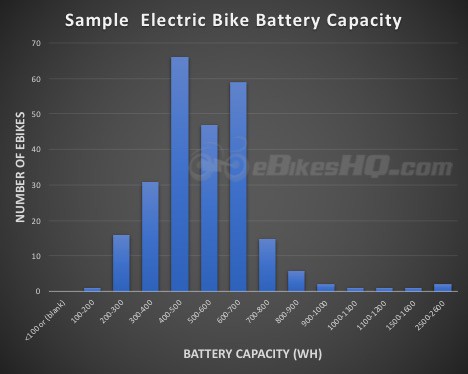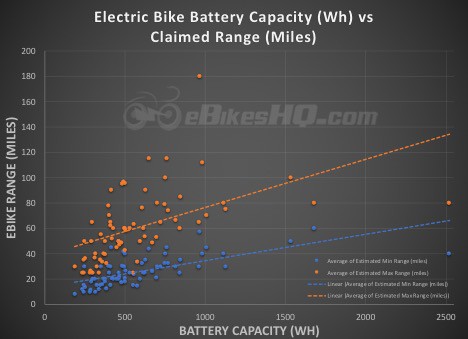The advantages of commuting by electric bike are many, but how far you can commute with an ebike is a key question for some. Although the average commuting distance for electric bikes is probably not that much higher than the average 9 mile commute for a traditional bike, the ability to travel much further on an electric bike is certainly a big advantage compared to a normal bike. When looking at a longer commute with an electric bike, the calculations and weighing the pros and cons can be complicated, but it really comes down to time and the capability of your electric bike.
You can technically commute as far as you’d like but there are practical limits to riding to work and the time it takes and the distance you can ride. When commuting by electric bike, if you want to have pedal assistance the whole time the key factor is the size of your battery, your “gas tank”, and whether you can charge your ebike battery at work. As an example, under ideal conditions and with the ability to fully recharge a very large battery (1000 Wh) I would estimate that you could commute approximately 50 miles (80 km) one way. This is a conservative estimate of energy used at 20 watt-hours per mile – which is equivalent to quite a bit of pedal assistance while riding.
At an average top speed of 28 mph (45 kph) (max Class 3 pedal assist speed in the US), this 50-mile commute would take approximately 1 hr and 47 minutes each way to complete. That’s a long commute!! And maybe too long, but it is possible and you could ride even further with a larger battery which is rare for off the shelf electric bikes.
The average speed above assumes that you will generally be traveling as fast as an ebike can take you (legally in the US in this case), with some stops at lights/stop signs, and making up some ground by going faster on the downhill. If you have a more urban commute with more stops and starts, your average speed would probably be less. If you have more open road or uninterrupted bike paths then your average speed may be higher.
How Big a do Electric Bike Batteries get?
Generally, electric bikes will have battery capacities in the range of 200 Wh – 700 Wh, and will be directly proportional to the range of your electric bike. The chart below shows a sample of various ebikes and their battery capacities. Only 5% of electric bikes I looked at had batteries with a capacity of over 800 Wh.

Some electric bike setups allow for 2 batteries connected together to effectively double your capacity.
If you’re building your own electric bike with a kit or putting the parts together yourself, then you have a few more options for larger battery packs. For example, Luna Cycle has larger battery packs with its largest clocking in at 1100 Wh.
Manufacturers Range Claims – Your Mileage May Vary
Like auto manufacturers and their stated fuel economy numbers, the stats given by manufacturers for their electric bike range should be taken as an optimal value that may not be reflective of your real-world experience. I’ve put the following chart together showing the battery capacity vs several manufacturers claimed minimum and maximum range for different models. As you can see the numbers vary widely – especially in the maximum range category! This is probably due to varying assumptions and testing conditions, and there are a lot of factors that can increase or decrease the range of a particular ebike as noted above. So take those numbers with a grain of salt.

There are a lot of factors in determining an exact distance and battery size (Wh) for commuting. I’ve put together this basic calculator that estimates the minimum size of batter based on a distance and type of power demand on that ride.
What Electric Bikes are Best for a Long Commute
Not a lot of off the shelf electric bikes have large capacity batteries over 1000 Wh), but the following might fit your requirements, it really depends on your specific needs, how far you need to go and how much you want to spend. Here are a few top rated ebikes to check out:
- Juiced Crosscurrent SX – with the 52V/ 19.5Ah battery (995 Wh pack) this electric bike is capable of 70+ miles of range. Starting at $2,499.
- Gocycle GS – A foldable bike with minimum 18 mile range – 50 mile maximum range. This electric bike starts at $2,700 and goes up from there with additional accessories. If you’re considering a combined train/bike commute, definitely check this one out.
- OHM Quest – This high-end commuter electric bike starts at $3,399 with a stated minimum range of 60 miles and a maximum range of 120 miles! With a maximum assisted speed of 20 mph, a long-distance commute will take a bit longer than with an ebike with a 28 mph max assist speed.
- Trek CrossRip+ – This Speed Pedelec (Class 3) will help you sustain speeds of up to 28 mph. The stated minimum range is 18 miles, with a maximum range of 92 miles.
An alternative to these would be to make your own custom electric bike with a kit that enables you to buy a higher capacity battery and really customize the bike to your needs and riding preferences.
Advantages To a Larger Battery
Even if you don’t think you’ll use the full capacity of a larger battery for a longer commute, having a bit extra in the tank is not such a bad thing. Generally, to extend the life of an ebike battery it’s recommended that Lithium-Ion batteries not be fully discharged or fully charged to 100%. By adhering to this the lifespan of the battery can be extended, which in the long run will extend the time you have before a replacement battery is needed – which can be one of the most expensive components of an electric bike. However, if you’re maxing out your battery daily due to the distance of your commute your battery capacity will wear out much more quickly (typically after about 1000 full charge cycles) than if you were charging it every few days.
Key Factors To Determine a Practical Commuting Distance For You
There are several key factors that will determine if an electric bike is practical for a long commute for you:
- Comfort – you might have or buy an electric bike that is capable of a phenomenal range, but if you’re still spending hours riding to and from work then this method of commute might not be practical.
- Ability to charge the battery at work – if you’re able to charge your battery at work then you can essentially double your commuting range with the largest battery available for your particular electric bike. As long as you can consistently charge every day then this may be a viable option for those with a longer commute but smaller battery capacity.
- Battery Size/age – the larger the battery, the higher the range of the electric bike. The older the battery the more reduction in total capacity from factory condition.
- Weight of Rider and gear – heavier means more work for the motor and more draw on the battery, resulting in less range
- Type of commute – are there lots of hills or is it very flat?
- Weather and seasonal conditions – colder temperatures will reduce the power and speed of the electric bike and drain the battery more quickly. Are there lots of windy conditions?
- Safety of Route – many times the shortest distance from home to work won’t be the safest for a cyclist. So this may increase your commute distance a little or a lot depending on the safe detour route for cyclists
- How much do you want to pedal? The more effort you put in, the less power will be required by the ebike to maintain the same speed. You could even change the type of riding you do in the morning (more pedal assistance to keep your ride relatively sweat-free) and afternoon (less assistance, more of a workout, but you get to shower when home)
Conclusion
I think the biggest recommendation I could make if you’re considering incorporating an electric bike into a long commute is “try before you buy”. You could speak with your local bike shop to see about any demo models they have to try out an electric bike for a few days before diving headfirst into it, or find someone locally who might lend you their ebike for a time to try it out. If you find that the commute is a bit too long to be practical, then all you would have lost is a few hours time and maybe some extra exercise.
But of course, whatever stage you’re at with riding an electric bike, enjoy the ride!
